Temperature Comparison of Looped and Vertical Carbon Nanotube Fibers during Field Emission
Abstract
1. Introduction
2. Experimental Methods
3. Results and Discussion
3.1. Field Emission Measurement
3.2. Temperature Distribution Measurement and Analysis
4. Conclusions
Author Contributions
Acknowledgments
Conflicts of Interest
References
- Shiffler, D.; Fairchild, S.; Tang, W.; Maruyama, B.; Golby, K.; LaCour, M.; Pasquali, M.; Lockwood, N. Demonstration of an Acid-Spun Single-Walled Nanotube Fiber Cathode. IEEE Trans. Plasma Sci. 2012, 40, 1871–1877. [Google Scholar] [CrossRef]
- Murray, P.T.; Back, T.C.; Cahay, M.M.; Fairchild, S.B.; Maruyama, B.; Lockwood, N.P.; Pasquali, M. Evidence for adsorbate-enhanced field emission from carbon nanotube fibers. Appl. Phys. Lett. 2013, 103, 053113. [Google Scholar] [CrossRef]
- Fairchild, S.B.; Boeckl, J.; Back, T.C.; Ferguson, J.B.; Koerner, H.; Murray, P.T.; Maruyama, B.; Lange, M.A.; Cahay, M.M.; Behabtu, N.; et al. Morphology dependent field emission of acid-spun carbon nanotube fibers. Nanotechnology 2015, 26, 105706. [Google Scholar] [CrossRef] [PubMed]
- Giubileo, F.; Di Bartolomeo, A.; Iemmo, L.; Luongo, G.; Urban, F. Field Emission from Carbon Nanostructures. Appl. Sci. 2018, 8, 526. [Google Scholar] [CrossRef]
- Behabtu, N.; Young, C.C.; Tsentalovich, D.E.; Kleinerman, O.; Wang, X.; Ma, A.W.K.; Bengio, E.A.; ter Waarbeek, R.F.; de Jong, J.J.; Hoogerwerf, R.E.; et al. Strong, Light, Multifunctional Fibers of Carbon Nanotubes with Ultrahigh Conductivity. Science 2013, 339, 182–186. [Google Scholar] [CrossRef] [PubMed]
- Zhang, P.; Fairchild, S.B.; Back, T.C.; Luo, Y. Field emission from carbon nanotube fibers in varying anode-cathode gap with the consideration of contact resistance. AIP Adv. 2017, 7, 125203. [Google Scholar] [CrossRef]
- Velasquez-Garcia, L.F.; Adeoti, B.; Niu, Y.; Akinwande, A.I. Uniform High Current Field Emission of Electrons from Si and CNF FEAs Individually Controlled by Si Pillar Ungated FETs. In Proceedings of the 2007 IEEE International Electron Devices Meeting, Washington, DC, USA, 10–12 December 2007; pp. 599–602. [Google Scholar]
- Chen, L.Y.; Velasquez-Garcia, L.F.; Wang, X.; Cheung, K.; Teo, K.; Akinwande, A.I. Design, fabrication and characterization of double-gated vertically aligned carbon nanofiber field emitter arrays. In Proceedings of the 2007 IEEE 20th International Vacuum Nanoelectronics Conference, Chicago, IL, USA, 8–12 July 2007; pp. 82–83. [Google Scholar]
- Chen, L.Y.; Velasquez-Garcia, L.F.; Wang, X.; Teo, K.; Akinwande, A.I. A Microionizer for Portable Mass Spectrometers Using Double-Gated Isolated Vertically Aligned Carbon Nanofiber Arrays. IEEE Trans. Electron Device 2011, 58, 2149–2158. [Google Scholar] [CrossRef]
- Teo, K.B.K.; Lee, S.-B.; Chhowalla, M.; Semet, V.; Binh, V.T.; Groening, O.; Castignolles, M.; Loiseau, A.; Pirio, G.; Legagneux, P.; et al. Plasma enhanced chemical vapour deposition carbon nanotubes/nanofibres—How uniform do they grow? Nanotechnology 2003, 14, 204. [Google Scholar] [CrossRef]
- Saito, Y.; Uemura, S. Field emission from carbon nanotubes and its application to electron sources. Carbon 2000, 38, 169–182. [Google Scholar] [CrossRef]
- Zakhidov, A.A.; Nanjundaswamy, R.; Obraztsov, A.N.; Zhang, M.; Fang, S.; Klesch, V.I.; Baughman, R.H.; Zakhidov, A.A. Field emission of electrons by carbon nanotube twist-yarns. Appl. Phys. A 2007, 88, 593–600. [Google Scholar] [CrossRef]
- Ryu, J.H.; Kang, J.S.; Park, K.C. Carbon Nanotube Electron Emitter for X-ray Imaging. Materials 2012, 5, 2353–2359. [Google Scholar] [CrossRef]
- Booske, J.H. Plasma physics and related challenges of millimeter-wave-to-terahertz and high power microwave generationa. Phys. Plasmas 2008, 15, 055502. [Google Scholar] [CrossRef]
- Gupta, A.P.; Park, S.; Yeo, S.J.; Jung, J.; Cho, C.; Paik, S.H.; Park, H.; Cho, Y.C.; Kim, S.H.; Shin, J.H.; et al. Direct Synthesis of Carbon Nanotube Field Emitters on Metal Substrate for Open-Type X-ray Source in Medical Imaging. Materials 2017, 10, 878. [Google Scholar] [CrossRef] [PubMed]
- Park, S.; Gupta, A.P.; Yeo, S.J.; Jung, J.; Paik, S.H.; Mativenga, M.; Kim, S.H.; Shin, J.H.; Ahn, J.S.; Ryu, J. Carbon Nanotube Field Emitters Synthesized on Metal Alloy Substrate by PECVD for Customized Compact Field Emission Devices to Be Used in X-Ray Source Applications. Nanomaterials 2018, 8, 378. [Google Scholar] [CrossRef] [PubMed]
- Minoux, E.; Groening, O.; Teo, K.B.K.; Dalal, S.H.; Gangloff, L.; Schnell, J.-P.; Hudanski, L.; Bu, I.Y.Y.; Vincent, P.; Legagneux, P.; et al. Achieving High-Current Carbon Nanotube Emitters. Nano Lett. 2005, 5, 2135–2138. [Google Scholar] [CrossRef] [PubMed]
- Evtukh, A.; Hartnagel, H.; Yilmazoglu, O.; Mimura, H.; Pavlidis, D. Vacuum Nanoelectronic Devices: Novel Electron Sources and Applications, 1st ed.; Wiley: Chichester, UK, 2015; ISBN 978-1-119-03795-8. [Google Scholar]
- Piltan, S.; Sievenpiper, D. Plasmonic nano-arrays for enhanced photoemission and photodetection. J. Opt. Soc. Am. B 2018, 35, 208–213. [Google Scholar] [CrossRef]
- Zhang, P.; Lau, Y.Y. Ultrafast and nanoscale diodes. J. Plasma Phys. 2016, 82, 595820505. [Google Scholar] [CrossRef]
- Zhang, P.; Valfells, A.; Ang, L.K.; Luginsland, J.W.; Lau, Y.Y. 100 years of the physics of diodes. Appl. Phys. Rev. 2017, 4, 011304. [Google Scholar] [CrossRef]
- Lin, J.; Wong, P.Y.; Yang, P.; Lau, Y.Y.; Tang, W.; Zhang, P. Electric field distribution and current emission in a miniaturized geometrical diode. J. Appl. Phys. 2017, 121, 244301. [Google Scholar] [CrossRef]
- Fairchild, S.B.; Bulmer, J.S.; Sparkes, M.; Boeckl, J.; Cahay, M.; Back, T.; Murray, P.T.; Gruen, G.; Lange, M.; Lockwood, N.P.; et al. Field emission from laser cut CNT fibers and films. J. Mater. Res. 2014, 29, 392–402. [Google Scholar] [CrossRef][Green Version]
- Purcell, S.T.; Vincent, P.; Journet, C.; Binh, V.T. Hot Nanotubes: Stable Heating of Individual Multiwall Carbon Nanotubes to 2000 K Induced by the Field-Emission Current. Phys. Rev. Lett. 2002, 88, 105502. [Google Scholar] [CrossRef] [PubMed]
- Sveningsson, M.; Hansen, K.; Svensson, K.; Olsson, E.; Campbell, E.E.B. Quantifying temperature-enhanced electron field emission from individual carbon nanotubes. Phys. Rev. B 2005, 72, 085429. [Google Scholar] [CrossRef]
- Cahay, M.; Zhu, W.; Fairchild, S.; Murray, P.T.; Back, T.C.; Gruen, G.J. Multiscale model of heat dissipation mechanisms during field emission from carbon nanotube fibers. Appl. Phys. Lett. 2016, 108, 033110. [Google Scholar] [CrossRef]
- Antoulinakis, F.; Chernin, D.; Zhang, P.; Lau, Y.Y. Effects of temperature dependence of electrical and thermal conductivities on the Joule heating of a one dimensional conductor. J. Appl. Phys. 2016, 120, 135105. [Google Scholar] [CrossRef]
- Zhang, P.; Lau, Y.Y. Scaling laws for electrical contact resistance with dissimilar materials. J. Appl. Phys. 2010, 108, 044914. [Google Scholar] [CrossRef]
- Tsentalovich, D.E.; Headrick, R.J.; Mirri, F.; Hao, J.; Behabtu, N.; Young, C.C.; Pasquali, M. Influence of Carbon Nanotube Characteristics on Macroscopic Fiber Properties. ACS Appl. Mater. Interfaces 2017, 9, 36189–36198. [Google Scholar] [CrossRef] [PubMed]
- Lu, L.; Yi, W.; Zhang, D.L. 3ω method for specific heat and thermal conductivity measurements. Rev. Sci. Instrum. 2001, 72, 2996–3003. [Google Scholar] [CrossRef]
- Fowler, R.H.; Nordheim, L. Electron Emission in Intense Electric Fields. Proc. R. Soc. Lond. Ser. A 1928, 119, 173–181. [Google Scholar] [CrossRef]
- Forbes, R.G. Field emission: New theory for the derivation of emission area from a Fowler–Nordheim plot. J. Vac. Sci. Technol. B Microelectron. Nanometer Struct. Process. Meas. Phenom. 1999, 17, 526–533. [Google Scholar] [CrossRef]
- Luginsland, J.W.; Valfells, A.; Lau, Y.Y. Effects of a series resistor on electron emission from a field emitter. Appl. Phys. Lett. 1996, 69, 2770–2772. [Google Scholar] [CrossRef][Green Version]
- Cahay, M.; Murray, P.T.; Back, T.C.; Fairchild, S.; Boeckl, J.; Bulmer, J.; Koziol, K.K.K.; Gruen, G.; Sparkes, M.; Orozco, F.; et al. Hysteresis during field emission from chemical vapor deposition synthesized carbon nanotube fibers. Appl. Phys. Lett. 2014, 105, 173107. [Google Scholar] [CrossRef]
- Lau, Y.Y.; Liu, Y.; Parker, R.K. Electron emission: From the Fowler—Nordheim relation to the Child—Langmuir law. Phys. Plasmas 1994, 1, 2082–2085. [Google Scholar] [CrossRef]
- Di Bartolomeo, A.; Scarfato, A.; Giubileo, F.; Bobba, F.; Biasiucci, M.; Cucolo, A.M.; Santucci, S.; Passacantando, M. A local field emission study of partially aligned carbon-nanotubes by atomic force microscope probe. Carbon 2007, 45, 2957–2971. [Google Scholar] [CrossRef]
- Baturin, S.S.; Zinovev, A.V.; Baryshev, S.V. Current Saturation in Nonmetallic Field Emitters. arXiv, 2017; arXiv:1710.03692. [Google Scholar]
- Greenwood, J.A.; Williamson, J.B.P. Electrical conduction in solids II. Theory of temperature-dependent conductors. Proc. R. Soc. Lond. A 1958, 246, 13–31. [Google Scholar] [CrossRef]
- Timsit, R.S. Remarks on the thermal stability of an Ohmic-heated nanowire. J. Appl. Phys. 2018, 123, 175105. [Google Scholar] [CrossRef]
- Li, C.; Thostenson, E.T.; Chou, T.-W. Dominant role of tunneling resistance in the electrical conductivity of carbon nanotube–based composites. Appl. Phys. Lett. 2007, 91, 223114. [Google Scholar] [CrossRef]
- Banerjee, S.; Luginsland, J.W.; Zhang, P. A Two Dimensional Tunneling Resistance Transmission Line Model for Parallel Contacts. 2018; in preparation. [Google Scholar]
- Zhang, P. Scaling for quantum tunneling current in nano- and subnano-scale plasmonic junctions. Sci. Rep. 2015, 5, 9826. [Google Scholar] [CrossRef] [PubMed]

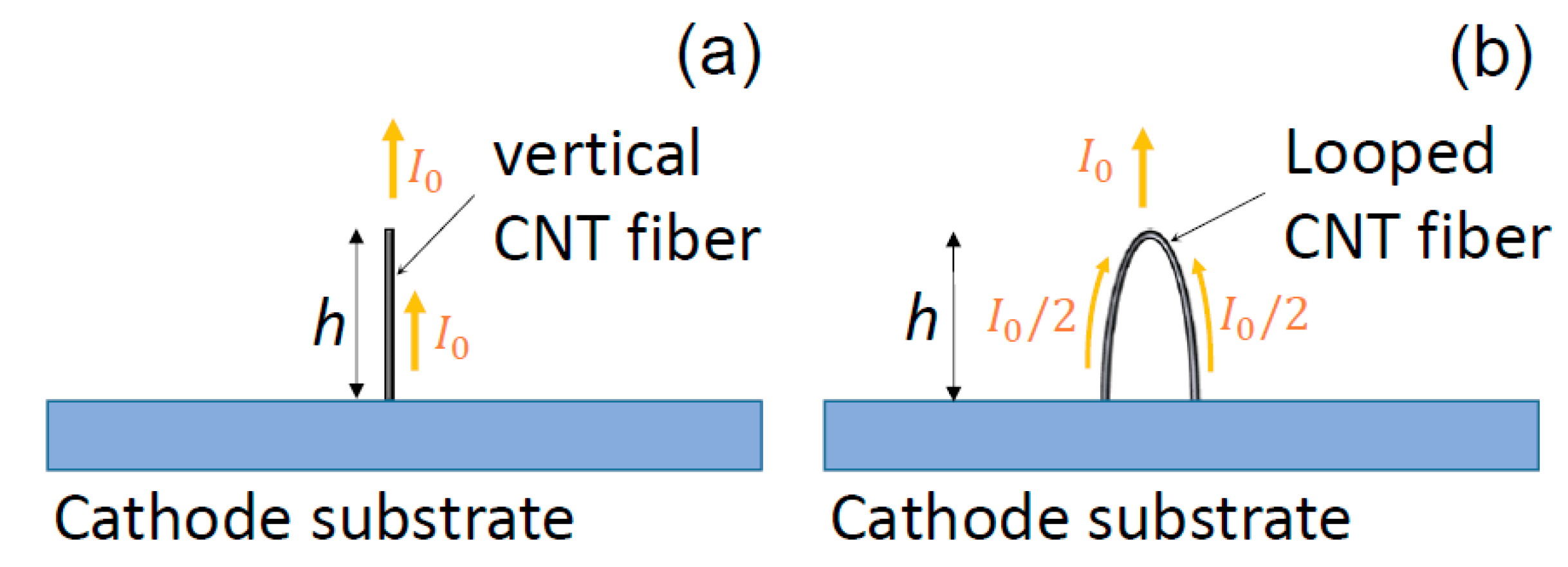

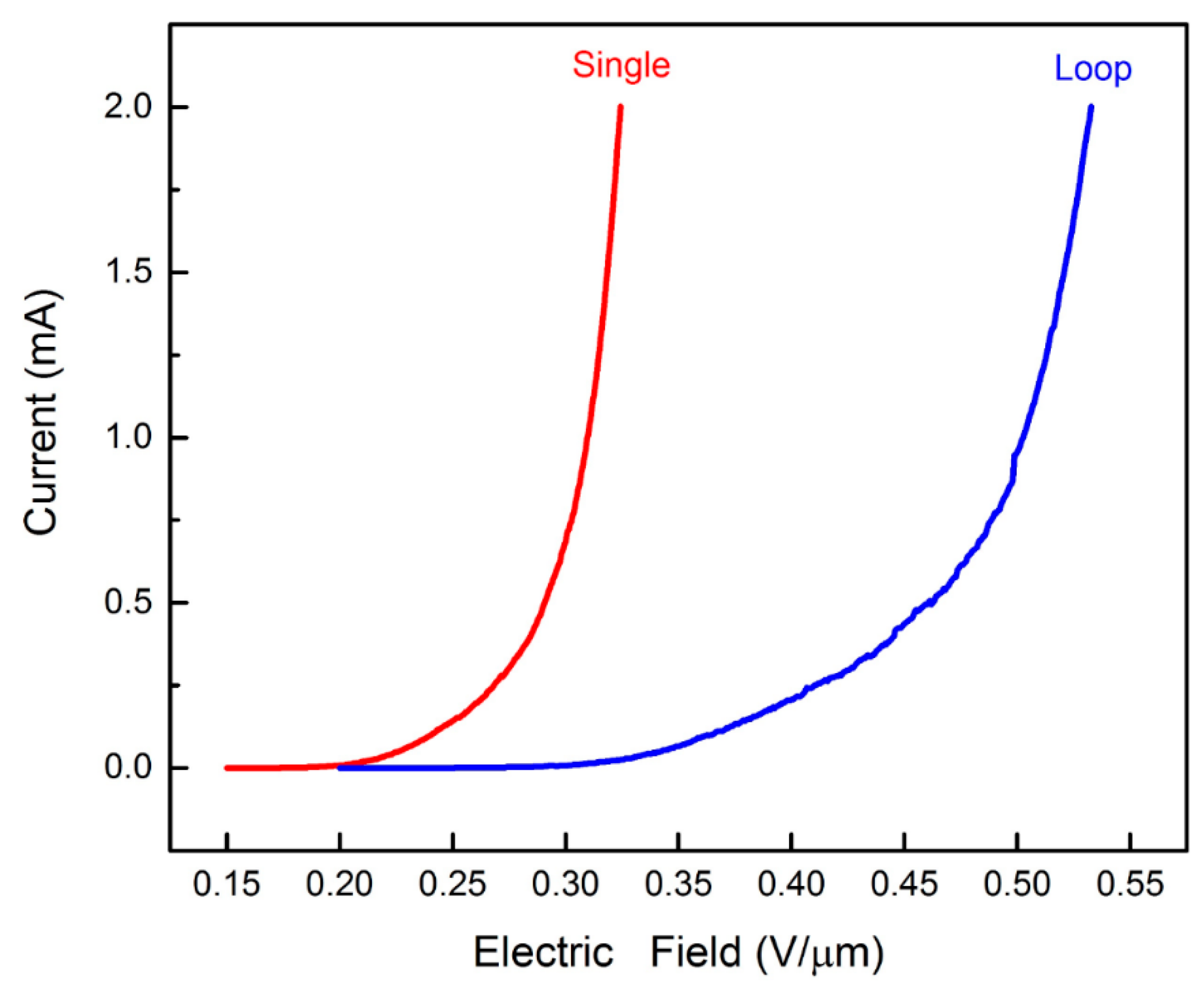
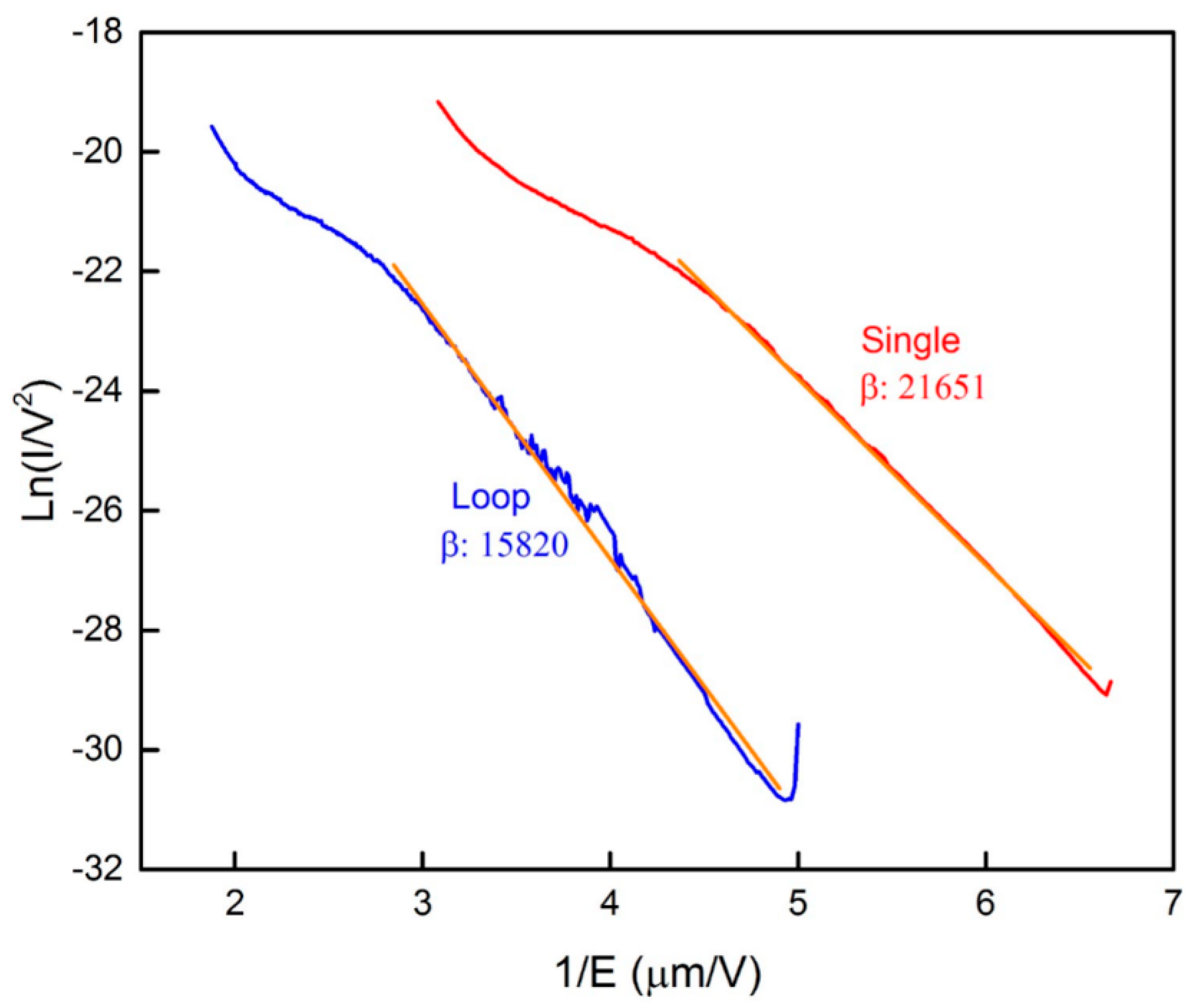

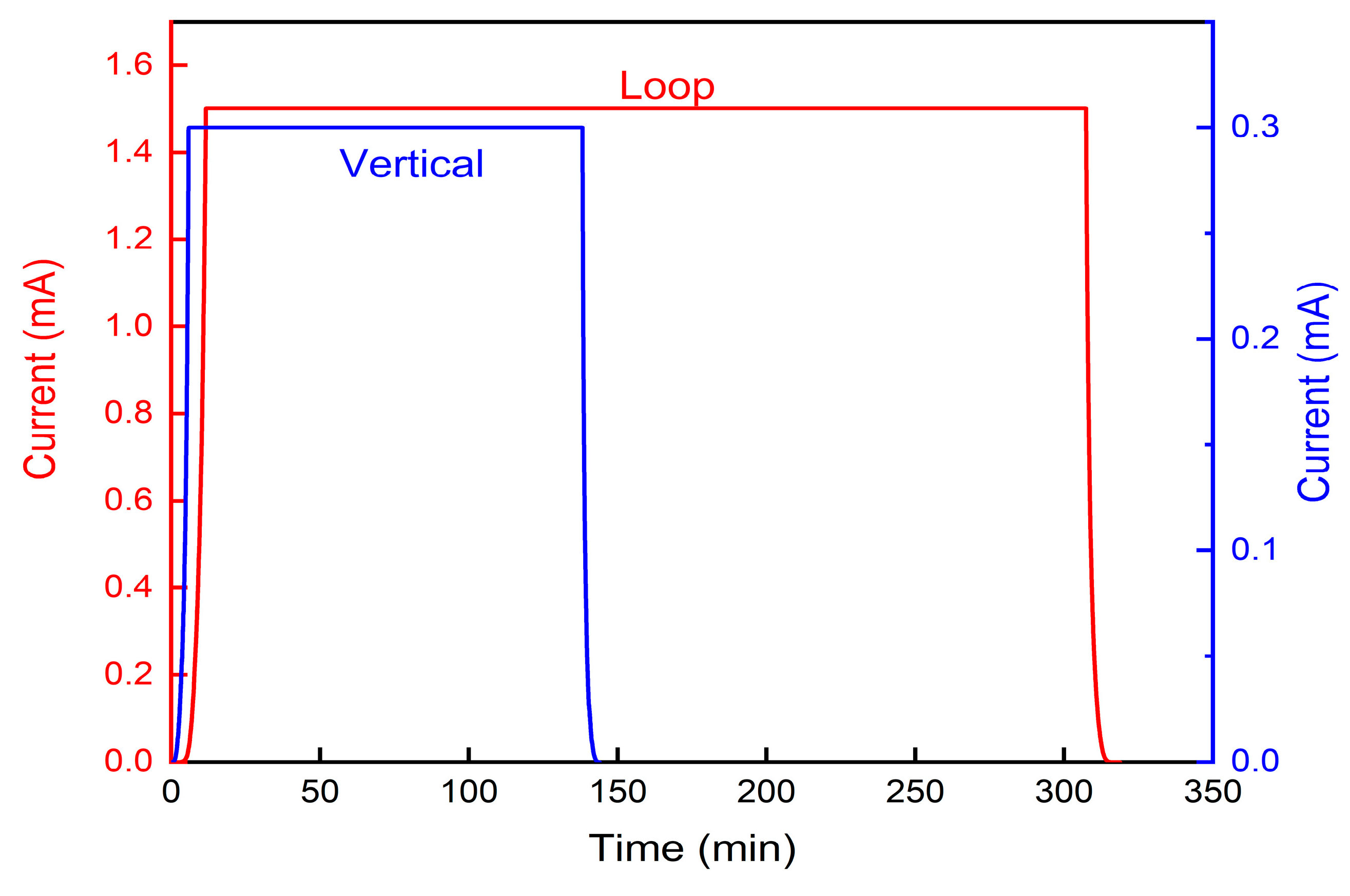
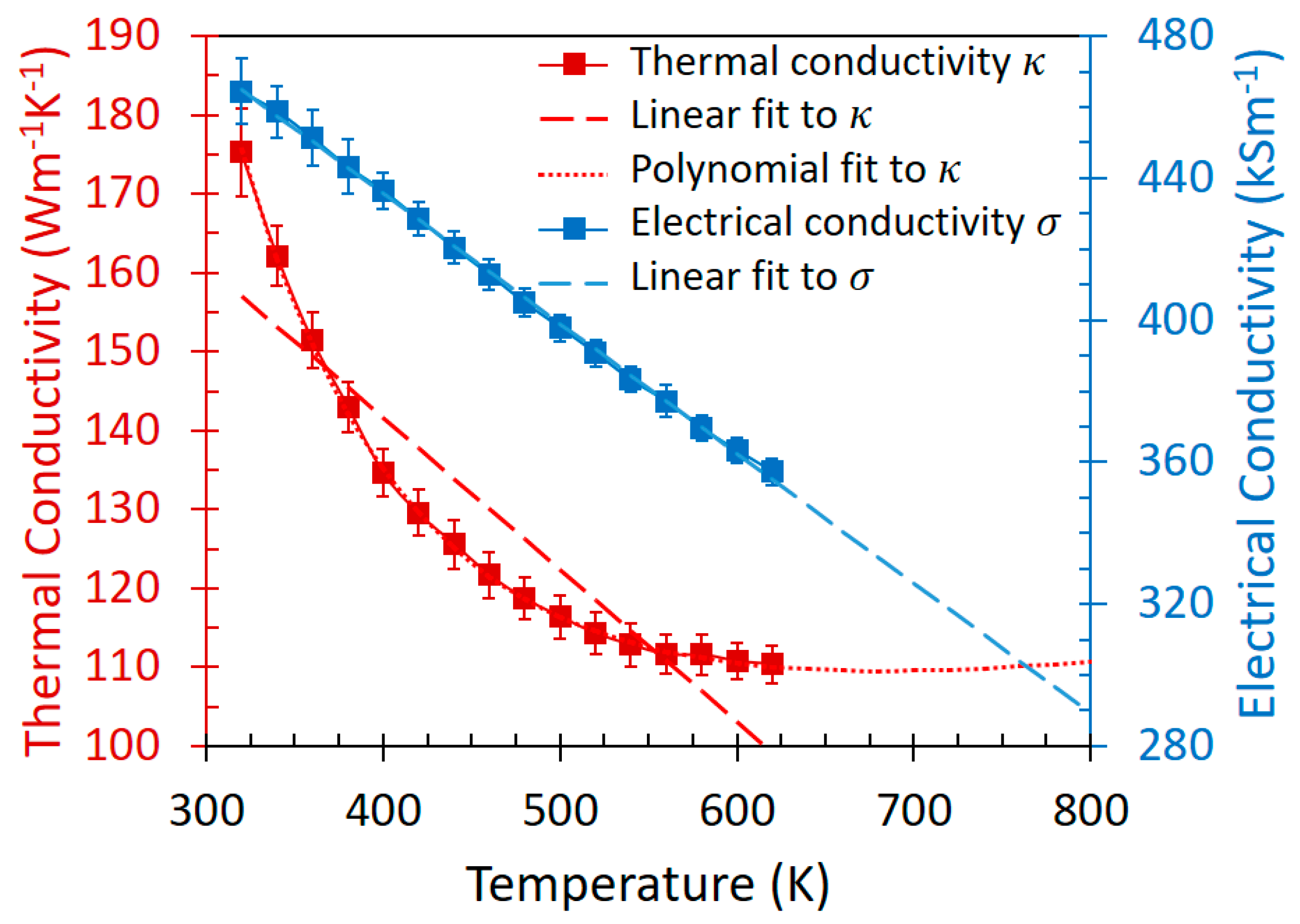
| Carbon Nanotube (CNT) Fiber Emitter | Measured | Constant and | Constant and Linear | Linear and Polynomial Fit to | |
|---|---|---|---|---|---|
| Vertical | [] | ~600 | 580 | 595 | 600 |
| [mm] | ~3.0 | 4 | 3.5 | 3.1 | |
| Looped | [] | ~300 | 254 | 286 | 300 |
| [mm] | ~4 | 4 | 4 | 4 | |
© 2018 by the authors. Licensee MDPI, Basel, Switzerland. This article is an open access article distributed under the terms and conditions of the Creative Commons Attribution (CC BY) license (http://creativecommons.org/licenses/by/4.0/).
Share and Cite
Zhang, P.; Park, J.; Fairchild, S.B.; Lockwood, N.P.; Lau, Y.Y.; Ferguson, J.; Back, T. Temperature Comparison of Looped and Vertical Carbon Nanotube Fibers during Field Emission. Appl. Sci. 2018, 8, 1175. https://doi.org/10.3390/app8071175
Zhang P, Park J, Fairchild SB, Lockwood NP, Lau YY, Ferguson J, Back T. Temperature Comparison of Looped and Vertical Carbon Nanotube Fibers during Field Emission. Applied Sciences. 2018; 8(7):1175. https://doi.org/10.3390/app8071175
Chicago/Turabian StyleZhang, Peng, Jeongho Park, Steven B. Fairchild, Nathaniel P. Lockwood, Yue Ying Lau, John Ferguson, and Tyson Back. 2018. "Temperature Comparison of Looped and Vertical Carbon Nanotube Fibers during Field Emission" Applied Sciences 8, no. 7: 1175. https://doi.org/10.3390/app8071175
APA StyleZhang, P., Park, J., Fairchild, S. B., Lockwood, N. P., Lau, Y. Y., Ferguson, J., & Back, T. (2018). Temperature Comparison of Looped and Vertical Carbon Nanotube Fibers during Field Emission. Applied Sciences, 8(7), 1175. https://doi.org/10.3390/app8071175





